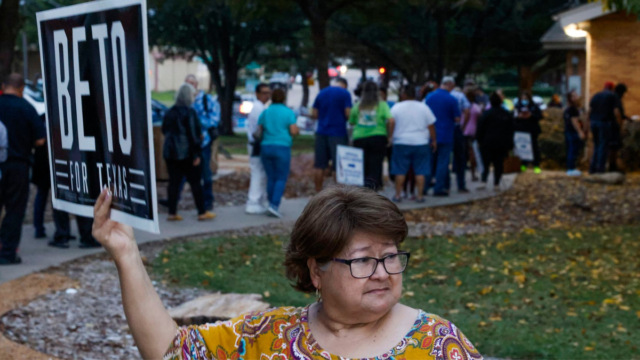
Last week’s reelection victory by Sen. Raphael Warnock over over Republican Herschel Walker gave Georgia Democrats their fourth statewide triumph in two years.
Once a Republican stronghold, the Peach State has grown purple, even though the GOP controls both houses of its Legislature. Georgia’s two senators are Democrats, a major shift in the Southern state’s political landscape. President Joe Biden won the state over Donald Trump in 2020, the first Democrat to do so since Bill Clinton in 1992.
Georgia’s emergence as a political battleground is a lesson for Texas Democrats who are looking to be more competitive against statewide Republican candidates.
Texas Democrats haven’t won a statewide race since 1994, and defeats in 2020 and 2022 signal that they remain a long way from breaking though.
Here are some lessons Texas Democrats should take from their counterparts in Georgia.
Building political infrastructure takes time
Georgia Democrats’ recent success didn’t happen overnight. Activists and organizers toiled for years to register voters, develop effective voter turnout models, build grassroots organizations and create a winning message.
Unlike the Texas situation, the efforts of Georgia Democrats didn’t stall or end after a string of defeats. They kept their eyes on the prize.
“Georgia Democrats and others worked for years to build out an infrastructure in order to win,” said state Rep. Jasmine Crockett, a Dallas Democrat who in November was elected to replace Democrat and longtime U.S. Rep. Eddie Bernice Johnson in Congress. “It’s required in Texas because the state — at three times to size of Georgia — is so big. It’s going to take a lot of work and patience.”
Grassroots groups played a key role. According to an analysis by former Georgia candidate for governor Stacey Abrams this year, nearly 1.3 million Georgians have registered to vote since her first bid in 2018. Out of those, 47% are people of color, 31.6% are Black and 43% are under age 30.
Abrams lost a rematch against Republican incumbent Gov. Brian Kemp, but the fruit from her 2018 contest could have helped other Democrats win.
The nonprofit progressive group New Georgia Project helped by mobilizing a coalition that its leaders describe as “Black, Latinx, AAPI and young Georgians.” AAPI stands for the Asian American and Pacific Islander community.
Like Texas, demographic shifts in Georgia favor Democrats, who must keep working hard to build a winning coalition.
Maximize urban vote
Georgia Democrats win statewide races by overwhelming their Republican rivals in Atlanta and many of its suburbs.
Texas Democrats racked up higher percentages than Republicans in urban areas, but many eligible voters in the state’s big cities don’t cast ballots.
In Dallas, Democratic candidate for governor Beto O’Rourke and the rest of the party’s ticket didn’t fully mine Democratic Party strongholds in southern Dallas. They left votes on the table, given that Dallas County voter turnout in the November general election was 44%.
In order for Texas Democrats to close the gap with Republicans, they have to increase voter turnout in Black and Latino neighborhoods. Activists should also continue robust voter turnout and voter education programs.
/cloudfront-us-east-1.images.arcpublishing.com/dmn/V535252GTJB7JPAOWSWFTQWCBI.jpg)
Voter mobilization by both parties should begin when Election Day is not looming and be tied to issues that matter to voters. When election season rolls around, residents should be registered and voter engagement already underway. That’s the approach of the nonpartisan Texas Organizing Project, a group that engages voters on issues like criminal justice reform. It’s a model other groups should replicate.
Meet voters where they actually are
The notion of “meeting voters where they are” has become a cliché. In Texas that means showing up at a restaurant, church or park, or knocking on doors during neighborhood canvassing. Candidates use social media and text voters on their smartphones with data from a master list of voters or people who show up at rallies.
In Georgia, Democrats took voter outreach to another level. Organizers have showed up at entertainment and sporting events for candidates. They mobilized music artists and popular DJs. Voter turnout appeals were made at Georgia strip clubs and bars. Meeting voters where they are means getting out of political comfort zones. There are voters everywhere.
Texas Democrats need to get more creative and aggressive with voter outreach.
Recruit better candidates
Warnock, with his thoughtfulness and oratory, stood out next to Walker, the former Cowboys standout and Heisman Trophy winner at Georgia who was criticized by many as not ready for prime time. A minister, Warnock was able to connect with the Black voters who dominate Democratic politics in Georgia.
Over the years Texas has had some good candidates, but generally the bulk of their statewide tickets have been composed of underfunded political unknowns. That’s what not having a statewide elected leader in nearly 30 years will do for the party’s bench.
Winning a statewide race will require a candidate with an inspirational message and lots of campaign cash. That’s hard to find, whether or not you’re in power.
/cloudfront-us-east-1.images.arcpublishing.com/dmn/5GOXHQ5JMRCYFOJVUIQG7K3RYM.jpg)
Money matters
At more than $425 million, the Warnock/Walker Senate race was one of the most expensive contests in American history.
If Texas Democrats want to compete, they’ll have to match the money being poured into GOP races. Yes, O’Rourke raised $80 million for his unsuccessful race for governor against Republican incumbent Greg Abbott. But the rest of the statewide ticket didn’t have enough money to make a difference.
That included Brownsville lawyer Rochelle Garza, who couldn’t get the financial backing needed to compete with Ken Paxton, the GOP incumbent attorney general who won despite being under indictment for securities fraud and the focus of an FBI investigation into public corruption.
Democrats should also pour money into down-ballot races. The action at the bottom helps candidates at the top of the ticket.









